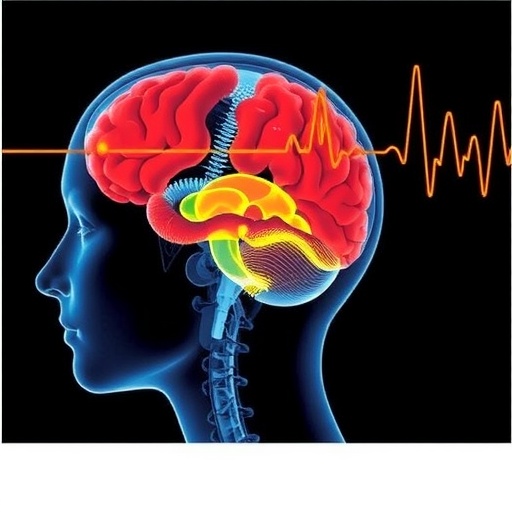Recent advancements in neuroscience have underscored the importance of understanding how the human brain operates in various physiological states. A cutting-edge study published in BMC Neuroscience delves into changes in brain and heart connectivity, specifically during tilt table testing with healthy young adults who do not exhibit syncope. This innovative research led by a team of experts, including A. Runnova, M. Zhuravlev, and M. Novikov, seeks to uncover subtle yet significant shifts in EEG and ECG signals that occur when individuals are subjected to postural changes.
The tilt table test has become a staple in the evaluation of cardiovascular response to changes in body position. This simple yet effective method simulates the transition from supine to upright posture, enabling researchers to observe how the body maintains homeostasis during physical strain. In the context of this study, the tilt table test serves as a crucial mechanism for investigating the intricate interplay between neural and cardiac processes. By focusing on healthy young adults, the researchers eliminate the potential confounding effects of pre-existing conditions, providing a clear view of the physiological responses to tilt.
A vital aspect of the study revolves around the heart and brain’s connectivity, as represented by EEG and ECG signals. The electroencephalogram (EEG) measures the electrical activity of the brain, reflecting neuron behavior and communication, while the electrocardiogram (ECG) captures the heart’s electrical activity. Understanding the connectivity between these two systems can provide insights into how the autonomic nervous system modulates cardiac rhythms in response to changes in posture. Researchers have long debated the bi-directional communication between the heart and the brain, and this study adds a new dimension to that conversation.
Researchers utilized advanced techniques to analyze the EEG and ECG signals, employing specific connectivity metrics to characterize the interaction patterns before, during, and after the tilt table procedure. This careful methodology allowed for the isolation of fluctuations that may be indicative of the brain’s adaptation to changes in physical orientation. The insights into connectivity differences not only elucidate cardiovascular reflexes but also reveal underlying neural mechanisms that contribute to maintaining balance and stability.
Interestingly, the study found that certain patterns in EEG signals, particularly in the frontal and parietal lobes, were closely correlated with variations in heart rate variability as measured by ECG. This suggests a synchronization between cognitive processes and autonomic control in real-time, shedding light on the neural substrates of cardiovascular regulation. Identifying such patterns can have implications for understanding various disorders related to syncope and other autonomic dysfunctions, reinforcing the significance of this research.
Tilt table testing simulates conditions that the body commonly experiences in everyday life, such as standing up from a seated position or walking. By examining the neural and cardiac responses in a controlled setting, researchers can draw parallels to situations that may provoke orthostatic intolerance—a condition where the body does not adjust adequately when moving to an upright position. The findings from this research could pave the way for developing predictive models for individuals at risk for syncope, contributing to improved clinical practices in managing such patients.
As the study population was limited to young, healthy adults, it raises questions about variability across different demographics. Future studies may expand this research to include a broader spectrum of age groups, individuals with pre-existing medical conditions, and those experiencing syncope. These avenues for exploration will likely yield valuable insights into how age and health status interact with the brain-heart axis during postural changes, thereby enhancing our grasp of human physiology.
Furthermore, the technological advancements in data acquisition and analysis play a pivotal role in this research narrative. The integration of machine learning algorithms for intricate signal processing demonstrates the potential to uncover nuanced associations between EEG and ECG metrics. As computational power continues to evolve, the ability to interpret vast data sets in real-time may offer new frontiers for understanding the complexity of human physiology.
Moreover, this research opens discussions regarding behavioral factors influencing heart-brain connectivity. Stress, anxiety, and overall mental wellness can dramatically affect both EEG and ECG readings. Future investigations could delve into how these psychological aspects correlate with physiologic responses during tilt table tests, enhancing the holistic understanding of health.
The implications of such studies extend beyond academia, reaching into everyday clinical applications. For instance, neurologists and cardiologists could jointly interpret shifts in connectivity patterns to create comprehensive strategies for managing patients with autonomic dysfunction. This collaborative approach may not only advance diagnosis but also therapeutic interventions tailored to individual physiological profiles.
As interest in the brain-heart connection grows within the scientific community, such pioneering studies set the stage for future breakthroughs in healthcare. They emphasize the need for interdisciplinary research that bridges cardiology, neurology, and psychology to generate more comprehensive models of human health.
In conclusion, the exploration of EEG and ECG connectivity during tilt table testing provides profound insights into the complex interplay between brain activity and cardiac function. The foundational knowledge gained through such research underscores the necessity of further inquiry into how these dynamics operate across different populations and contexts, ultimately enriching the scientific discourse surrounding human physiology and health management.
Subject of Research: EEG and ECG signal connectivity during tilt table testing in healthy young adults without syncope.
Article Title: Changes in EEG and ECG signal connectivity during tilt table testing in healthy young adults without syncope.
Article References: Runnova, A., Zhuravlev, M., Novikov, M. et al. Changes in EEG and ECG signal connectivity during tilt table testing in healthy young adults without syncope. BMC Neurosci 26, 64 (2025). https://doi.org/10.1186/s12868-025-00982-4
Image Credits: AI Generated
DOI: https://doi.org/10.1186/s12868-025-00982-4
Keywords: EEG, ECG, connectivity, tilt table test, syncope, cardiovascular response, neuroscience, brain-heart interaction, physiological adaptation.




